From our front-page news:
Yesterday, Intel made a surprise announcement regarding a "long-term strategic" cooperation with TSMC (Taiwan Semiconductor Manufacturing Company) to help produce Atom processors. Although at this point in time, the announcement is about a memorandum of understanding, we can expect to see the TSMC producing Intel's 32nm Atom processors in the near-future.
This announcement marks the first time Intel has ever ported a processor to an external source, and given the number of fabs that the company already operates, what benefit do they actually hope to see here? According to the press release, it's so that Intel can gain more exposure to other markets, but as Ars Technica reports, there's no doubt a lot more to it than that.
The problem in theory is simple. Intel's desktop processors aren't in demand right now, but their Atom processors are... and they are selling them by the bucket-load. However, each Atom processor costs significantly less to the customer than a desktop CPU, so Intel has to sell a lot more of them in order to see profit. The situation is made even worse when Intel has to spend lots on R&D and also devote fabs to Atom... a product that will never generate near as much revenue as a fab that produces desktop processors.
So by having the TSMC help produce Atom CPUs, they can use their R&D elsewhere, and also free up some space in their own fabs for production of other products. It's still all a very sticky situation though, because this move proves that Intel cannot rely on Atom for much of anything... the money simply isn't there. The economy isn't helping their desktop CPU situation either, so until that all clears out, Intel is in a complicated position.

Intel's margins on Atom are much thinner than those on regular desktop and server CPUs, and with each process shrink, Atom's cost (and price) will go down. But fabs get more expensive with each shrink, so the result is that Intel has to sell many more Atoms at 32nm than it does at 45nm to make money. The demand for all of those Atoms may or may not materialize, which is why Intel will pay TSMC to fab them and share the risk that the demand may not be there. Meanwhile, Intel wants to save its (very costly) in-house fab capacity for high-margin products, like its CPUs.
Source: Ars Technica
This announcement marks the first time Intel has ever ported a processor to an external source, and given the number of fabs that the company already operates, what benefit do they actually hope to see here? According to the press release, it's so that Intel can gain more exposure to other markets, but as Ars Technica reports, there's no doubt a lot more to it than that.
The problem in theory is simple. Intel's desktop processors aren't in demand right now, but their Atom processors are... and they are selling them by the bucket-load. However, each Atom processor costs significantly less to the customer than a desktop CPU, so Intel has to sell a lot more of them in order to see profit. The situation is made even worse when Intel has to spend lots on R&D and also devote fabs to Atom... a product that will never generate near as much revenue as a fab that produces desktop processors.
So by having the TSMC help produce Atom CPUs, they can use their R&D elsewhere, and also free up some space in their own fabs for production of other products. It's still all a very sticky situation though, because this move proves that Intel cannot rely on Atom for much of anything... the money simply isn't there. The economy isn't helping their desktop CPU situation either, so until that all clears out, Intel is in a complicated position.

Intel's margins on Atom are much thinner than those on regular desktop and server CPUs, and with each process shrink, Atom's cost (and price) will go down. But fabs get more expensive with each shrink, so the result is that Intel has to sell many more Atoms at 32nm than it does at 45nm to make money. The demand for all of those Atoms may or may not materialize, which is why Intel will pay TSMC to fab them and share the risk that the demand may not be there. Meanwhile, Intel wants to save its (very costly) in-house fab capacity for high-margin products, like its CPUs.
Source: Ars Technica
